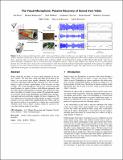| dc.contributor.author | Davis, Abe | |
| dc.contributor.author | Rubinstein, Michael | |
| dc.contributor.author | Wadhwa, Neal | |
| dc.contributor.author | Mysore, Gautham J. | |
| dc.contributor.author | Durand, Fredo | |
| dc.contributor.author | Freeman, William T. | |
| dc.date.accessioned | 2015-11-24T14:22:15Z | |
| dc.date.available | 2015-11-24T14:22:15Z | |
| dc.date.issued | 2014-07 | |
| dc.identifier.issn | 07300301 | |
| dc.identifier.uri | http://hdl.handle.net/1721.1/100023 | |
| dc.description.abstract | When sound hits an object, it causes small vibrations of the object's surface. We show how, using only high-speed video of the object, we can extract those minute vibrations and partially recover the sound that produced them, allowing us to turn everyday objects---a glass of water, a potted plant, a box of tissues, or a bag of chips---into visual microphones. We recover sounds from high-speed footage of a variety of objects with different properties, and use both real and simulated data to examine some of the factors that affect our ability to visually recover sound. We evaluate the quality of recovered sounds using intelligibility and SNR metrics and provide input and recovered audio samples for direct comparison. We also explore how to leverage the rolling shutter in regular consumer cameras to recover audio from standard frame-rate videos, and use the spatial resolution of our method to visualize how sound-related vibrations vary over an object's surface, which we can use to recover the vibration modes of an object. | en_US |
| dc.description.sponsorship | Qatar Computing Research Institute | en_US |
| dc.description.sponsorship | National Science Foundation (U.S.) (CGV-1111415) | en_US |
| dc.description.sponsorship | National Science Foundation (U.S.). Graduate Research Fellowship (Grant 1122374) | en_US |
| dc.description.sponsorship | Massachusetts Institute of Technology. Department of Mathematics | en_US |
| dc.description.sponsorship | Microsoft Research (PhD Fellowship) | en_US |
| dc.language.iso | en_US | |
| dc.publisher | Association for Computing Machinery (ACM) | en_US |
| dc.relation.isversionof | http://dx.doi.org/10.1145/2601097.2601119 | en_US |
| dc.rights | Creative Commons Attribution-Noncommercial-Share Alike | en_US |
| dc.rights.uri | http://creativecommons.org/licenses/by-nc-sa/4.0/ | en_US |
| dc.source | MIT web domain | en_US |
| dc.title | The visual microphone: Passive recovery of sound from video | en_US |
| dc.type | Article | en_US |
| dc.identifier.citation | Abe Davis, Michael Rubinstein, Neal Wadhwa, Gautham J. Mysore, Fredo Durand, and William T. Freeman. 2014. The visual microphone: passive recovery of sound from video. ACM Trans. Graph. 33, 4, Article 79 (July 2014), 10 pages. | en_US |
| dc.contributor.department | Massachusetts Institute of Technology. Computer Science and Artificial Intelligence Laboratory | en_US |
| dc.contributor.department | Massachusetts Institute of Technology. Department of Electrical Engineering and Computer Science | en_US |
| dc.contributor.department | Massachusetts Institute of Technology. Department of Mathematics | en_US |
| dc.contributor.mitauthor | Davis, Abe | en_US |
| dc.contributor.mitauthor | Rubinstein, Michael | en_US |
| dc.contributor.mitauthor | Wadhwa, Neal | en_US |
| dc.contributor.mitauthor | Durand, Fredo | en_US |
| dc.contributor.mitauthor | Freeman, William T. | en_US |
| dc.relation.journal | ACM Transactions on Graphics | en_US |
| dc.eprint.version | Author's final manuscript | en_US |
| dc.type.uri | http://purl.org/eprint/type/ConferencePaper | en_US |
| eprint.status | http://purl.org/eprint/status/NonPeerReviewed | en_US |
| dspace.orderedauthors | Davis, Abe; Rubinstein, Michael; Wadhwa, Neal; Mysore, Gautham J.; Durand, Fredo; Freeman, William T. | en_US |
| dc.identifier.orcid | https://orcid.org/0000-0002-3707-3807 | |
| dc.identifier.orcid | https://orcid.org/0000-0003-1469-2696 | |
| dc.identifier.orcid | https://orcid.org/0000-0002-2902-6752 | |
| dc.identifier.orcid | https://orcid.org/0000-0001-9919-069X | |
| dc.identifier.orcid | https://orcid.org/0000-0002-2231-7995 | |
| mit.license | OPEN_ACCESS_POLICY | en_US |
| mit.metadata.status | Complete | |
